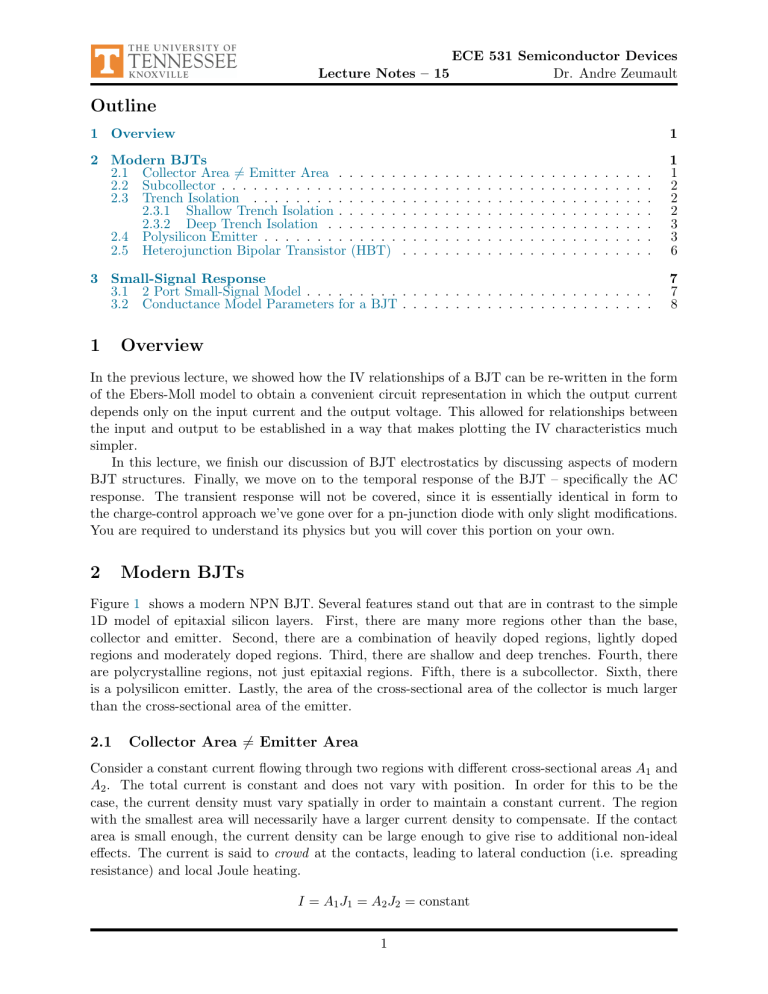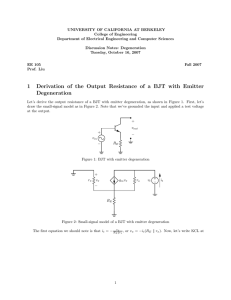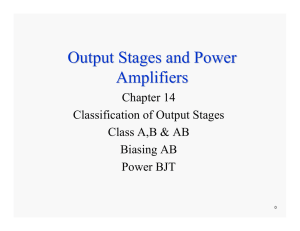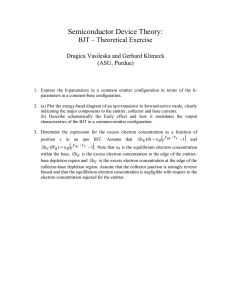
Lecture Notes – 15 ECE 531 Semiconductor Devices Dr. Andre Zeumault Outline 1 Overview 1 2 Modern BJTs 2.1 Collector Area 6= Emitter Area . . . . . . 2.2 Subcollector . . . . . . . . . . . . . . . . . 2.3 Trench Isolation . . . . . . . . . . . . . . 2.3.1 Shallow Trench Isolation . . . . . . 2.3.2 Deep Trench Isolation . . . . . . . 2.4 Polysilicon Emitter . . . . . . . . . . . . . 2.5 Heterojunction Bipolar Transistor (HBT) . . . . . . . 1 1 2 2 2 3 3 6 3 Small-Signal Response 3.1 2 Port Small-Signal Model . . . . . . . . . . . . . . . . . . . . . . . . . . . . . . . . . 3.2 Conductance Model Parameters for a BJT . . . . . . . . . . . . . . . . . . . . . . . . 7 7 8 1 . . . . . . . . . . . . . . . . . . . . . . . . . . . . . . . . . . . . . . . . . . . . . . . . . . . . . . . . . . . . . . . . . . . . . . . . . . . . . . . . . . . . . . . . . . . . . . . . . . . . . . . . . . . . . . . . . . . . . . . . . . . . . . . . . . . . . . . . . . . . . . . . . . . . . . . . . . . . . . . . . Overview In the previous lecture, we showed how the IV relationships of a BJT can be re-written in the form of the Ebers-Moll model to obtain a convenient circuit representation in which the output current depends only on the input current and the output voltage. This allowed for relationships between the input and output to be established in a way that makes plotting the IV characteristics much simpler. In this lecture, we finish our discussion of BJT electrostatics by discussing aspects of modern BJT structures. Finally, we move on to the temporal response of the BJT – specifically the AC response. The transient response will not be covered, since it is essentially identical in form to the charge-control approach we’ve gone over for a pn-junction diode with only slight modifications. You are required to understand its physics but you will cover this portion on your own. 2 Modern BJTs Figure 1 shows a modern NPN BJT. Several features stand out that are in contrast to the simple 1D model of epitaxial silicon layers. First, there are many more regions other than the base, collector and emitter. Second, there are a combination of heavily doped regions, lightly doped regions and moderately doped regions. Third, there are shallow and deep trenches. Fourth, there are polycrystalline regions, not just epitaxial regions. Fifth, there is a subcollector. Sixth, there is a polysilicon emitter. Lastly, the area of the cross-sectional area of the collector is much larger than the cross-sectional area of the emitter. 2.1 Collector Area 6= Emitter Area Consider a constant current flowing through two regions with different cross-sectional areas A1 and A2 . The total current is constant and does not vary with position. In order for this to be the case, the current density must vary spatially in order to maintain a constant current. The region with the smallest area will necessarily have a larger current density to compensate. If the contact area is small enough, the current density can be large enough to give rise to additional non-ideal effects. The current is said to crowd at the contacts, leading to lateral conduction (i.e. spreading resistance) and local Joule heating. I = A1 J1 = A2 J2 = constant 1 Lecture Notes – 15 ECE 531 Semiconductor Devices Dr. Andre Zeumault Figure 1: Modern NPN BJT The ratio of the current densities is defined by the ratio of the area of the contacts as in Figure 2 ... J2 A1 = A2 J1 In a BJT, the effect of current crowding in the emitter contact is to create a lateral component of the emitter current. Since any component of the emitter current other than the forward injected current leads to a diminished emitter efficiency, the net effect will be to reduce the DC current gain of the device. 2.2 Subcollector The subcollector provides a low resistance contact to the moderately doped collector region. Since a parasitic BJT exists between the base, collector and substrate, the subcollector effectively shunts this parasitic conduction path and prevents possible punch through of the collector base junction into that of the substrate. The subcollector prevents any parasitic BJT action due to a floating substrate bias. 2.3 2.3.1 Trench Isolation Shallow Trench Isolation The shallow trenches are formed of insulating materials, usually SiO2 . The shallow trench isolation separates the two heavily doped regions–the diffused base contact and the subcollector–from be2 Lecture Notes – 15 ECE 531 Semiconductor Devices Dr. Andre Zeumault Figure 2: Two electrical contacts of different areas A1 and A2 , flowing a constant current I between them. coming electrically coupled. Since these regions are heavily doped and biased, they will modulate depletion widths in their vicinity and could potentially touch, leading to punch through. The isolation prevents this. Furthermore, the subcollector is a lateral contact to the collector well, which would otherwise produce a significant lateral current component and reduce current gain if the shallow trench did not force current flow to be vertical within the BJT stack. Shallow trenches prevent leakage currents between the heavily doped subcollector and the diffused base contact. 2.3.2 Deep Trench Isolation The deep trenches are also formed of insulating materials, usually SiO2 . These serve to electrically isolate adjacent BJTs from one another. Since only a very small base current is required to forward bias the base-emitter junction of a BJT, parasitic currents need to be properly isolated to avoid undesired switching. Deep trenches provide electrical isolation between devices. 2.4 Polysilicon Emitter Modern BJTs have two emitters, an epitaxial (aka epi-emitter) and a polysilicon (aka poly-emitter) as shown in Figure 3 for a NPN BJT. The reason there are two emitters stems from a technological limitation in how emitters are fabricated rather than a stroke of genius in the design of the device. In practice, the emitter regions of a BJT is scaled to smaller physical widths. We haven’s spoken of 3 Lecture Notes – 15 ECE 531 Semiconductor Devices Dr. Andre Zeumault Figure 3: Modern NPN BJT with a poly-emitter a parametric dependence of the BJT IV characteristics upon the emitter width WE . Why? Because we have made the long-diode approximation for the emitter and collector boundary conditions. In other words, the contacts, we have mathematically treated as being positioned at ∞. If the emitter width is finite, there will be a dependence upon the emitter width. When the emitter width becomes comparable to the minority carrier diffusion length, diffusion will become negligble, and the carrier injection into this region will increase. Since this corresponds to an injection process that is antithesis of desired BJT operation, this leads to a reduction in the emitter efficiency and a reduction in the DC current gain. Thin emitters lead to a reduction in DC current gain. (more back injection) To combat this reduction in the current gain due to the thin emitter, a clever trick is used that exploits current continuity in the emitter stack. A second emitter, a poly-silicon emitter or poly-emitter is deposited on top of the single-crystalline epi-emitter. At first glance, there should be no functional change in the device characteristic, if anything we’ve effectively added to the total emitter width. This is not exactly true. The poly-emitter is polycrystalline and will have a lower electron and hole mobility due to increased scattering from grain-boundaries. This fact, combined with current continuity can be used to show that the carrier injection from the base to the epi-emitter is reduced, and the emitter efficiency no longer degraded. We illustrate this with a PNP BJT. The current density evaluated at the epi-emitter junction is... Jdif f,epi,E = eDepi,E d∆nepi,E dxE Likewise, the current density in the poly-emitter is given by... Jdif f,poly,E = eDpoly,E 4 d∆npoly,E dxE Lecture Notes – 15 ECE 531 Semiconductor Devices Dr. Andre Zeumault Figure 4: Excess minority carrier distributions in (a) epi-emitter and (b) poly-emitter configuration Current continuity dictates that the current must be continuous at the boundary... AE Jdif f,epi,E = AE Jdif f,poly,E d∆npoly,E d∆nepi,E eDepi,E = eDpoly,E dxE dxE d∆npoly,E d∆nepi,E = kb T µpoly,E kb T µepi,E dxE dxE In the last line the Einstein relation was used to write the diffusion constant in terms of the mobility. This gives a relationship between the ratio of the mobility in the two regions and the slope of the carrier concentrations in these regions. µepi,E = µpoly,E d∆npoly,E dxE d∆nepi,E dxE Since the mobility in the epi region is higher, the slope in the poly region will be higher or equivalently, the slope in the epi region lower. The reduction in the slope in the epi region directly translates into a lower diffusion current IEn and a higher emitter efficiency based on the ratio of the mobility in the two regions... µpoly,E d∆npoly,E d∆nepi,E = dxE µepi,E dxE This results in a lower emitter current due to back injection of electrons and a higher emitter efficiency, and therefore a higher DC current gain. We can visualize this in Figure 4 . 5 Lecture Notes – 15 2.5 ECE 531 Semiconductor Devices Dr. Andre Zeumault Heterojunction Bipolar Transistor (HBT) A simple solution to reduce the effects of base-width modulation would be to increase the base doping NB . However, this would lead to a reduction in the DC current gain according to ... 1 αDC = cosh W LB + DE LB nE0 DB LE pB0 sinh W LB n2 ...due to a reduction in pB0 = NBi . A clever method of circumventing this tradeoff between current gain and base-width modulation is through the use of heterojunctions. A heterojunction is an interface between two dissimilar materials. Examples of heterojunctions include semiconductordielectric and metal-semiconductor interfaces. To see why the use of a heterojunction in a BJT makes sense, one can re-write the expression for αDC in terms of explicit ni dependencies in the base and emitter regions as niB and niE respectively. αDC = cosh W LB + DE LB DB LE 1 niE niB 2 NB NE sinh W LB There is a dependence of the DC current gain on the ratio of the intrinsic carrier concentrations of the emitter and base region. Since ni depends only on material-specific parameters–bandgap energy, effective conduction band and valence band density of states–when the emitter and base are made of the same material, the ratio is 1 and has no ability to modify the gain. When they are dissimilar, this ratio can be used to offset changes in base doping. For example, if niB >> niE , the base doping can be increased to reduce base width modulation without reducing current gain. To achieve this, the base is implemented with a material having a smaller bandgap than the emitter. Eg,B < Eg,E The effect is to increase ni in the base relative to ni in the emitter according to the difference in bandgap energy. p −Eg,E ni,E = NC,E NV,E exp 2kB T p −Eg,B ni,B = NC,B NV,B exp 2kB T s ni,E NC,E NV,E Eg,E − Eg,B = exp − ni,B NC,B NV,B 2kB T This shows that the current gain can be increased by choosing the bandgap of the emitter to be larger than that of the base, independent of the doping of the base! HBTs allow the base doping to be increased without sacrificing gain. 6 Lecture Notes – 15 3 3.1 ECE 531 Semiconductor Devices Dr. Andre Zeumault Small-Signal Response 2 Port Small-Signal Model Small signal modeling of any circuit is straightforward within the two-terminal black box description. We envision a black box consisting of unknown circuit element(s) and we define relations between the terminal currents and voltages. I1 = g11 V1 + g12 V2 I2 = g21 V1 + g22 V2 We can make explicit, the dependencies of the current on the terminal voltages... I1 (V1 , V2 ) = g11 V1 + g12 V2 I2 (V1 , V2 ) = g21 V1 + g22 V2 If we assume that a small signal component exists for each terminal voltage... I1 (V1 + v1 , V2 + v2 ) = g11 (V1 + v1 ) + g12 (V2 + v2 ) I2 (V1 + v1 , V2 + v2 ) = g21 (V1 + v1 ) + g22 V2 + v2 ) For the left hand side, we can perform a Taylor series expansion about v1 = 0 and v2 = 0 to obtain... ∂I1 ∂I1 I1 (V1 , V2 ) + v1 + v2 = g11 (V1 + v1 ) + g12 (V2 + v2 ) ∂V1 v2 ∂V2 v1 ∂I2 ∂I2 I2 (V1 , V2 ) + v1 + v2 = g21 (V1 + v1 ) + g22 (V2 + v2 ) ∂V1 v2 ∂V2 v1 Eliminating the common terms, we arrive at the following... ∂I1 ∂I1 v1 + v2 = g11 v1 + g12 v2 ∂V1 v2 ∂V2 v1 ∂I2 ∂I2 v1 + v2 = g21 v1 + g22 v2 ∂V1 v2 ∂V2 v1 ...from which it is evident that... g11 ≡ g21 ≡ ∂I1 ∂V1 ∂I2 ∂V1 g12 ≡ v2 g22 ≡ v2 ∂I1 ∂V2 ∂I2 ∂V2 v1 v1 These are the small-signal two-port parameters in a conductance representation. 7 Lecture Notes – 15 3.2 ECE 531 Semiconductor Devices Dr. Andre Zeumault Conductance Model Parameters for a BJT For an npn BJT, the two port parameters are as follows: ∂IB ∂IB g11 ≡ g12 ≡ ∂VBE vCE ∂VCE vBE ∂IC ∂IC g21 ≡ g22 ≡ ∂VBE vCE ∂VCE vBE ...where the terminal currents are defined as ib = g11 vbe + g12 vce ic = g21 vbe + g22 vce For an pnp BJT, the two port parameters are as follows: ∂IB ∂IB g12 ≡ g11 ≡ ∂VEB vEC ∂VEC vEB ∂IC ∂IC g21 ≡ g22 ≡ ∂VEB vEC ∂VEC vEB ...where the terminal currents are defined as ib = g11 veb + g12 vec ic = g21 veb + g22 vec One can work out the expressions for the conductances using the Ebers-Moll model representation. 8





